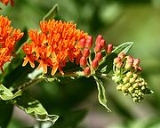
Butterfly weed
Encyclopedia
Asclepias tuberosa is a species of milkweed
native to eastern North America
. It is a perennial plant
growing to 0.3–1 m (0.984251968503937–3.3 ) tall, with clustered orange or yellow flower
s from early summer to early fall. The leaves
are spirally arranged, lanceolate, 5–12 cm long and 2–3 cm broad.
This plant favors dry, sand or gravel soil, but has also been reported on stream margins. It requires full sun.
It is commonly known as Butterfly Weed because of the butterflies
that are attracted to the plant by its color and its copious production of nectar. It is also the larval
food plant of the Queen
and Monarch butterflies. Hummingbirds, bees and other insects are also attracted.
Extracts were used by Native Americans
as an expectorant for wet coughs and other pulmonary ailments. Use of the herb is contraindicated in pregnancy, during lactation or with infants due to the small amount of cardiac glycoside
s.
Asclepias
Asclepias L. , the milkweeds, is a genus of herbaceous perennial, dicotyledonous plants that contains over 140 known species...
native to eastern North America
North America
North America is a continent wholly within the Northern Hemisphere and almost wholly within the Western Hemisphere. It is also considered a northern subcontinent of the Americas...
. It is a perennial plant
Perennial plant
A perennial plant or simply perennial is a plant that lives for more than two years. The term is often used to differentiate a plant from shorter lived annuals and biennials. The term is sometimes misused by commercial gardeners or horticulturalists to describe only herbaceous perennials...
growing to 0.3–1 m (0.984251968503937–3.3 ) tall, with clustered orange or yellow flower
Flower
A flower, sometimes known as a bloom or blossom, is the reproductive structure found in flowering plants . The biological function of a flower is to effect reproduction, usually by providing a mechanism for the union of sperm with eggs...
s from early summer to early fall. The leaves
Leaf
A leaf is an organ of a vascular plant, as defined in botanical terms, and in particular in plant morphology. Foliage is a mass noun that refers to leaves as a feature of plants....
are spirally arranged, lanceolate, 5–12 cm long and 2–3 cm broad.
This plant favors dry, sand or gravel soil, but has also been reported on stream margins. It requires full sun.
It is commonly known as Butterfly Weed because of the butterflies
Butterfly
A butterfly is a mainly day-flying insect of the order Lepidoptera, which includes the butterflies and moths. Like other holometabolous insects, the butterfly's life cycle consists of four parts: egg, larva, pupa and adult. Most species are diurnal. Butterflies have large, often brightly coloured...
that are attracted to the plant by its color and its copious production of nectar. It is also the larval
Caterpillar
Caterpillars are the larval form of members of the order Lepidoptera . They are mostly herbivorous in food habit, although some species are insectivorous. Caterpillars are voracious feeders and many of them are considered to be pests in agriculture...
food plant of the Queen
Queen (butterfly)
The Queen Butterfly is a North and South American butterfly in the family Nymphalidae with a wingspan of 2.75–3.25" . It is orange or brown with black wing borders and small white forewing spots on its dorsal wing surface, and reddish ventral wing surface fairly similar to the dorsal surface...
and Monarch butterflies. Hummingbirds, bees and other insects are also attracted.
Extracts were used by Native Americans
Indigenous peoples of the Americas
The indigenous peoples of the Americas are the pre-Columbian inhabitants of North and South America, their descendants and other ethnic groups who are identified with those peoples. Indigenous peoples are known in Canada as Aboriginal peoples, and in the United States as Native Americans...
as an expectorant for wet coughs and other pulmonary ailments. Use of the herb is contraindicated in pregnancy, during lactation or with infants due to the small amount of cardiac glycoside
Cardiac glycoside
Cardiac glycosides are drugs used in the treatment of congestive heart failure and cardiac arrhythmia. These glycosides are found as secondary metabolites in several plants, but also in some animals, such as the milkweed butterflies. -Function:...
s.
Identification
The plant looks similar to the Lanceolate Milkweed (Asclepias lanceolata), but is uniquely identified by the larger number of flowers, and the hairy stems that are not milky when broken. It is most commonly found in fields with dry soil.Subspecies indicated
- Asclepias tuberosa interior (Central United States)
- Asclepias tuberosa rolfsii – Rolfs Milkweed (Southeastern United States)
- Asclepias tuberosa tuberosa (Eastern United States)
Common names
Common names include Butterfly Weed, Canada Root, Chigger Flower, Chiggerflower, Fluxroot, Indian Paintbrush, Indian Posy, Orange Milkweed, Orange Swallow-wort, Pleurisy Root, Silky Swallow-wort, Tuber Root, Yellow Milkweed, White-root, and Windroot, and also butterfly loveExternal links
- Butterfly weed brief information and pictures
- USDA information
- Missouri Botanical Garden Asclepias tuberosa (native plant without Milky Stems)
- Missouri Botanical Garden Asclepias tuberosa 'Hello Yellow (cultivar with Milky Stems)

